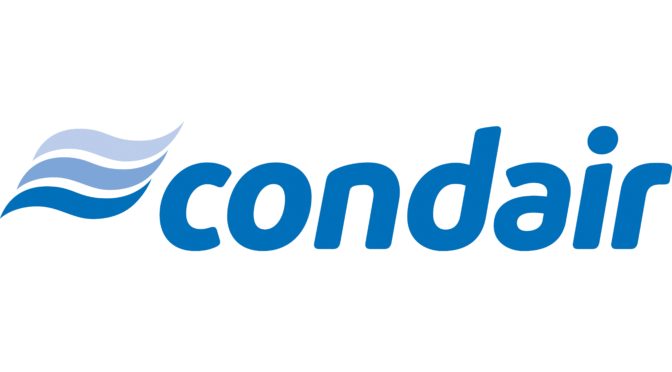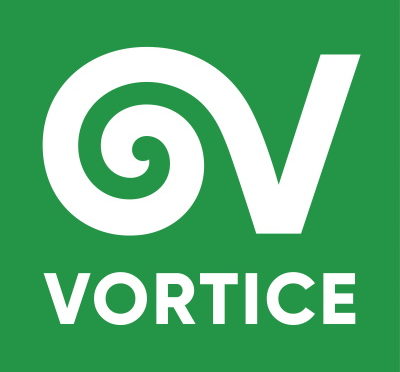All posts by admin
CONDAIR IN TUNE WITH STEINWAY
Story
Steinway & Sons, synonymous with building the world’s best and finest pianos for over 160 years, recently refurbished its impressive London showroom in Marylebone. The company required its contractor to create the optimum environmental conditions to prevent the wood used to craft these precision instruments from warping. Condair’s resistive steam (RS) humidifiers were specified and then installed in three rooms in the building, including the basement where the workshop is situated. All the units are feeding steam into air handling units to maintain the vital humidity levels required.
Steinway’s UK managing director, Craig Terry, explains: “Incredibly rare and expensive wood is used in some of our models – but actually any type of wood is susceptible to changes in environmental conditions. Dryness is the enemy of pianos so humidity is really important. We need 40% to 50% humidity all the time to protect the wood, whether they’re in the showroom or the workshop. Condair’s units are ideal for the job.
“And because we rely so heavily on the reliability of the humidifiers, we also contracted with Condair to service the humidifiers at regular intervals. Would I recommend Condair? Oh yes, they’ve supplied great service.”
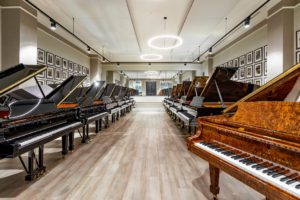
If these precision musical instruments, which are worth many thousands of pounds each, are exposed to dry air it can change the instrument’s dimensions very slightly. This would be detrimental to their performance and result in them requiring much more frequent tuning, eventually leading to permanent deterioration over time. Thankfully, Condair’s RS humidifiers provide the perfect protection.
The Condair RS humidifiers installed at Steinway are capable of creating up to 16kg/h of humidity but the range has models offering maximum outputs from 5 to 160kg/h. The humidifier delivers accurate control without the expense of plastic disposable boiling cylinders, simplifying maintenance and keeping downtime to a minimum. Scale that forms on the heating elements breaks off under normal operation and falls into the externally located scale collector tank. Scale removal is a simple process of draining the tank with the push of a button, allowing the unit to cool then disconnecting the tank and emptying it.
An advanced touchscreen control panel makes operation simple, while providing detailed diagnostic reporting. In addition, a USB connection allows performance data to be downloaded into Excel and the humidifier’s software to be easily updated.
Dave Marshall-George, UK Sales Director at Condair, added: “Humidity control for Steinway is of particular importance during winter in the UK. As soon as the weather turns cold, indoor humidity may drop below the required 40%RH. However, air conditioning systems will also dry the air, so the humidification system will have been in regular use. Basically, whenever there’s a requirement to precisely control the environmental conditions around the pianos, the humidifiers will automatically do exactly what’s needed of them.
“We really value our relationship with Steinway and appreciate their faith in both the capability of the Condair RS humidifiers and our service engineers, who keep them running in tip top condition.”
The Condair Group is the world’s leading specialist in humidification, dehumidification and evaporative cooling, with technologies for commercial, industrial and heritage applications. The company offers system design, manufacture, supply, installation, commissioning, maintenance and spares. You can find out more by visiting the company’s website at www.condair.co.uk.
View Condair's profile:
ECO-LOGIC ‘Brand Leader’ Interview Podcast 2 – Transcript to support learning
Story
‘How adding the ECO-LOGIC Trans-Sense range of ‘non-touch’ sensor products at an early stage in Washroom and Bathroom system designs can help to mitigate the spread of COVID-19 in a variety of settings’
ECO-LOGIC ‘Brand Leader’ Interview Podcast – Transcript to support learning
Every effort has been made to flawlessly transcribe the interview to support learning but please consider the recorded audio of the interview as the actual source of information for learning purposes.
Hi this is Mick de Leiburne and welcome to this special edition of the BNE Product News ‘Brand Leader’ podcast for the Construction & Building Services industry, where we look at product innovations that meet the evolving specification needs for product specifiers. In this edition we look at the latest challenges for Washroom and Bathroom System specification in a variety of settings.
Well, the Covid-19 virus is rapidly bringing to the forefront, more than ever before, the urgent necessities for Architects, Interior Designers, Building Services Engineers and building owners to, where possible, specify products that can help to eliminate the spread of the virus and any other existing and future viruses and diseases in all building sectors.
So, for starters, Non-Touch would be good – to provide a high standard of health and safety, and then, what if you could also throw in Attractive Design, Simple to Install and Ultra Safe to use, add to that Easy Clean Surfaces, Anti Vandal/Ligature design for special projects such as hospitals, secure buildings, schools and other public use buildings, along with Substantial Water and Energy Saving and the icing on the cake: Smart Home and Central Computer Control.
Well, Coverway Ltd’s ECO-LOGIC electronic Trans-Sense ‘sensing product’ range offers all of these characteristics and benefits – to a whole variety of building projects.
And Dudley Moore, Design Consultant Engineer for the ECO-Logic range and a popular guest on this podcast, now joins us on the phone to tell us more:
Hi Dudley
Hello Mick
Well Dudley, Trans-Sense is clearly a highly specifiable product on many levels, but today let’s talk about the detail, very appropriately for these times, relating to the Health & Safety issue of what influences specification of Trans-Sense to mitigate the spread of bacteria and viruses. Can you first give us an Overview on how Trans-Sense meets the needs for this element of specification for the product type?
The Trans-Sense non touch sensor product range is the ideal product to be specified for the control of Sanitary ware for basins and sink Taps, WC’s, Urinals, Bath Fill to any level you want, Showering and other items such as for Non-Touch Door, Cupboard door and Drawer opening/closing for example and also operating other products.
If set in the non-Touch operating mode, the system provides a very high standard specification for Health and Safety.
For Health hygiene – the non-Touch sensing system eliminates cross-contamination, (other features include) ease of use, anti-vandal/ligature proof (if required) and providing a clean unobtrusive wall surface, due to the sensor being fitted behind the wall/panel surfaces.
Electrical Safety – the product range is powered and operated through 6V Ultra Low Voltage, this being 6v DC. This is provided either through just battery power or through a 240v -6v mains reduced power pack with battery backup to mains power failure, thereby still offering use of the sanitary ware under mains power failure conditions.
And now can we look at suitability of Trans-Sense for specific settings. Let’s start with Domestic Housing. How can the product help to protect ‘one household’ for example?
To stop cross-contamination in a domestic setting, the Trans-Sense non-touch product range is available for non-Touch operation of the Basin Taps, Kitchen and Utility sink taps, WC’s (full and Economy flushing) and Bath Fill with Touch sense control for the shower facilities.
And what about stopping cross-contamination in Commercial Buildings – where more than one household is using the building?
For office developments the Trans–Sense Non-Touch product is available for Basin Tap control (using our own tap outlet range or other manufacturers tap outlets), also for sinks, WC’s and Urinals in the building.
I would of thought that Trans-Sense ‘Non-Touch’ would also be perfect for Hotel project specification – where there is a high turnover of people from different households passing through?
For hotel projects and developments, complete En-Suite bathroom sanitary ware controls are available for the basin tap, shower, WC and Bath filling, also the Toilet Blocks and Changing Rooms: – for control of Banks of Basins, WC’s and Urinals and for the Kitchens for basins, sinks, pot boiling and other sanitary ware in the building.
How about Trans-Sense ‘Non-Touch’ for Education Establishments – Schools, Academy’s, University’s etc? Once again, a lot of different households mixing there on a daily basis when open for learning during term times and also some areas such as sports halls are made available for third party sports clubs, dance clubs for example?
For these projects Trans-Sense products are available for Toilet Blocks, for banks of Basins, Showers, WC’s and Urinals, and complete range of En-Suite bathroom controls for university student accommodation projects.
What are the challenges that Trans-Sense can meet for Healthcare Establishments – for example General Hospitals, Mental Health Care/Hospitals, Dentist, Doctor Surgery’s, Care Homes?
For these projects the Non-Touch Trans-Sense product range is substantial for Sanitary ware controls for Wards, En-suite Bathrooms, Consulting rooms, Toilet blocks etc, Kitchens for Taps and Sinks, Pot Boiling and many other areas.
A range of Trans-Sense sensing products are also available for Non-Touch Door, Cupboard and Draws for auto or demand Opening/Closing formats. This range is especially important for Hospitals, Surgery’s and Dentist specification type projects.
How about the unique requirements of Secure Building specifications such as
Prisons, Mental Healthcare Hospital and Immigration Centers – for example
The large Trans-Sense product range we have for this sector is especially important to the specifier and client. The sensors being fixed to the rear of the wall/panel surface provides the design consultants/engineers with a unique product, meeting all the specification demands that the client requires for these buildings, including an extremely high standard of specification for Health and Safety, including the non-Touch feature that helps to protect all users of the building by mitigating the spread of virus and bacteria driven diseases and protect the Patients and Inmates from Self Harm.
Well, Coverway’s ECO-LOGIC Trans-Sense ‘sensing product’ clearly offers a broad range of state-of the art specifications, including answering the many questions now being raised for specifying products in Domestic and Commercial buildings, Hospitals, Schools, Secure and many others – for new and refurbishment building design – to help eliminate the spread of the COVID-19 virus in this unprecedented pandemic, along with other existing and future viruses and diseases.
Thank you for joining us today Dudley
Thank you for inviting me and I look forward to hearing from the many Architects, Interior Designers, Building Service Engineers, Domestic Housing Developers who I know listen to this podcast. Please remember that it is important to talk to us as early as possible within the design process to incorporate the Trans Sense sensor into the construction design. Look forward to hearing from you all, goodbye.
Well, it’s been a pleasure speaking with you Dudley, thanks for coming on the podcast again and look forward to speaking to you again soon. Cheers.
For details on how specifiers listening to this podcast can contact Dudley Moore to discuss Trans-Sense in relation to a specific project that they are working on we have included relevant details on how to contact him in the description for this podcast.
You can also see and hear more about Coverway’s ECO-LOGIC product range by visiting their profile page in the BNE Construction & Building Services | Audio Visual virtual exhibition to access more podcast content…. just search for ECO-LOGIC and click on their logo.
View ECO-LOGIC UK's profile:
Recotherm ‘Brand Leader’ Interview Podcast 2 – Transcript to support learning
Story
‘How Swimming Pool Operators can help to mitigate the spread of COVID-19 in their pool areas and provide an indoor pool environment that allows people to have a healthy and comfortable swim in the fresh air’
Recotherm ‘Brand Leader’ Interview Podcast – Transcript to support learning
Every effort has been made to flawlessly transcribe the interview to support learning but please consider the recorded audio of the interview as the actual source of information for learning purposes.
Hi, this Mick de Leiburne for BusinessNet Explorer and welcome to this ‘Special Edition’ BNE Product News ‘Brand Leader’ Project Viewpoint podcast.
So, going for a swim in the fresh air – that sounds really healthy, doesn’t it? A combination of exercise and fresh air sounds just perfect, in fact probably highly recommended in the current situation for those fit enough to do so, but you would quite rightly picture yourself being outdoors when doing it. So, what about when the weather gets cooler, how close can Indoor Pool operators get to re-creating this healthy, hopefully ‘COVID-19 free’ swimming environment, within a building for pool users? We thought we would ask industry thought leader Martin Killen, MD at Recotherm, and a popular guest on this podcast series, if and how this can be achieved?
Martin joins us on the phone…. Hi Martin, thanks for joining us for this ‘Special Edition’ BNE Product News ‘Brand Leader’ Project Viewpoint podcast….
Thank you for inviting me Mick.
Always a pleasure…
So firstly, what is the current guidance regarding ‘indoor swimming pool ventilation’ and what is your response when an Indoor Pool operator asks for your advice regarding ‘mitigating the spread of COVID-19’ in their pool areas?
What should I do about COVID-19?
I wish I had a pound for every time I’ve been asked that question in the last nine months!
My expertise lies in swimming pools, so any comments I make are specifically related to swimming pools. There is no specific information from the Government with regards to pools, but we can apply the Governments general guidance which has been produced, in conjunction with the CIBSE (Chartered Institute of Building Services Engineers). You can look this up online, but the main points are: –
Wherever possible run the units on full fresh air. Run the ventilation systems for longer. When unoccupied run the systems at lower speed to keep the air moving instead of switching them off. Avoid re-circulation between rooms. Where the unit is serving a single space is less of a concern. The main objective is to avoid stagnation…
So how does this apply specifically in an indoor swimming pool environment?
Normally in a swimming pool we are serving a single area, so recirculation is acceptable. There are a lot of companies on the market that use mechanical dehumidifiers and only introduce a small amount of fresh air, indeed there are some that don’t introduce fresh air, at all. These companies will find it difficult to comply with the latest government recommendations without fundamentally redesigning their units. That is because the fresh air they have to introduce, because of COVID 19, will eliminate the need for a mechanical dehumidifier. Most of the units on the market that use mechanical dehumidification do not have any other form of heat recovery on the fresh air, so they become total loss systems discharging heat into the atmosphere.
I know you are a fresh air fan, in fact your brand is renowned to be one of the clear leaders in this technology for ventilating swimming pools. Can you tell us more about what Recotherm can offer the market as a ‘fresh air solution’ for ‘indoor swimming pool ventilation’?
At Recotherm we have always championed the use of full fresh air as the best way of dehumidifying the pool hall, so every unit we sell can bring in large amounts of fresh air. Indeed, wherever possible, we have designed our units to be able to run on full fresh air, even in the middle of winter when the ambient temperature is at its lowest.
Are there any downsides to switching to full fresh air?
There is a downside to switching to full fresh air. In the Winter the ambient air contains very little moisture so only a small amount, say 10-20%, is required to control the humidity. Under these circumstances the Recotherm units would normally reduce the amount of fresh air introduced, but if we are to stipulate that they must operate at a higher fresh air rate, then the internal humidity will drop. This will increase the evaporation from the pool and thus increase the running cost – but it also makes the wet occupants feel colder as the water on their bodies evaporates quicker.
It sounds like there is a need to strike a balance somehow – between safety and comfort?
I feel we need to be flexible. We need to increase the level of fresh air, but not to a point where we are deterring people from coming to the pool because they feel cold. It may well be that in 5 years’ time, when we have had time to analyse the data, we will find out that COVID cannot live in the swimming pool environment. But for the moment we need to err on the side of caution and increase the amount of fresh air to a level that is sustainable without affecting the daily running of the pool.
Well Martin thank you again for joining us on the BNE Product News podcast for the Construction & Building Services industry and sharing with us some of the thought leadership that drives the Recotherm brands ongoing ability to research and engineer solutions and develop products to help Pool Operators maintain an Indoor Swimming Pool environment that is just as ‘healthy’ as swimming ‘outdoors in the fresh air’. Fantastic work!
Thank you, Mick.
Cheers
For more information about the Recotherm range of products – please go to www.recotherm.co.uk
View Recotherm's profile:
ECO-LOGIC ‘Brand Leader’ Interview Podcast 1 – Transcript to support learning
Story
‘Product innovations designed to meet modern specification needs for Washroom and Bathroom Systems in Workspaces and Residential environments’
ECO-LOGIC ‘Brand Leader’ Interview Podcast 1 – Transcript to support learning
Every effort has been made to flawlessly transcribe the interview to support learning but please consider the recorded audio of the interview as the actual source of information for learning purposes.
Hi this is Mick de Leiburne for BusinessNet Explorer.
And welcome to the latest edition of our Project Viewpoint series of interviews – with Brand Leaders in the Construction & Building Services industry where we look at the brands that are continually innovating in a marketplace ever hungry for state-of-the-art product and service solutions to meet specific industry needs.
In this edition we look at saving water, saving energy, saving money and improving health and safety, all really important issues for people and our planet and there is one innovative brand that has developed a product range that supports all of these objectives. The ECO-LOGIC Trans-Sense product range, already successfully being utilised in specialist environments such as secure, leisure, healthcare and education, is now receiving growing interest with specifiers and building designers working on projects for more mainstream environments, such as offices and residential properties as these issues are now increasingly under the spotlight and clearly on the agenda for everyone.
We are joined today by Dudley Moore, a design consultant for the ECO-LOGIC brand an innovative brand with a revolutionary design concept that has now been at the forefront of water and energy management in a variety of sectors for many years.
Dudley joins us on the phone….Hi Dudley and welcome to the Project Viewpoint podcast for the Construction & Building Services industry and thank you for joining us today.
Hello and thanks for inviting me to talk about Trans-Sense.
You’re very welcome! Dudley, before we look at specification considerations relating to modern washroom and bathroom systems for Residential and Workplace projects, can you tell us a little about what Trans-Sense offers specifiers and building designers, that has already led to specification success in many sectors?
OK, from an overall specification viewpoint, the Trans-Sense sensor is the ideal product for control of taps, WC’s, urinals and blockage sensing of urinals and WC’s etc. I say ‘ideal product’ as it covers all relevant aspects of health and safety, sustainability and maintenance.
The Eco-Logic Electronic Trans-Sense sensing system offers Non-Touch or Touch Sensing.
If you set it in the non-touch mode, the sensor provides a high standard for health and safety as the non-touch sensing system eliminates cross contamination. It is also easy to use, and provides a clean unobtrusive wall surface due to the sensor being fitted behind the wall/panel surfaces. This also makes the product vandal resistant and ligature proof, therefore ideal for those specifications.
The safety focus is increased even further as our product range is run from ultra-low voltage 6V DC power supply or 6V batteries. Our 230V-6V power supplies include battery backup, which also then allows use of the sanitary ware under mains power failure.
So Trans-Sense is clearly very specifiable from a health and safety perceptive, how about from a sustainability viewpoint?
Water and energy are saved as the controls can be set to the client’s exact operating and fill time requirements, eliminating waste of water and energy (that’s if hot water is used of course).
Perfect for cost savings as well, and finally how about from a maintenance perspective?
For urinals the sensor is installed on the waste pipe, again providing clean wall surfaces which architects like to provide. Due to the sensor being fitted behind the wall, there is no accessibility by vandals to damage the sensors and providing an uncluttered wall surface and hence a luxury finish to the area, which the architects like of course.
The Trans-Sense sensor can also be used for blockage sensing for urinals and WC’s. Blockages in urinals and WC’s are a large problem in many installations.
For this specification, two sensors are fitted, one before the trap, the other sensor is fitted on the waste pipe after the trap.
The Trans-Sense blockage system can be linked to an LED control panel in the Facilities’ office or connected to a computer system, which will indicate when a blockage occurs. The system will automatically shut down the urinal or WC if a blockage occurs, sending the information back to the indicating panel or central computer to be attended to by maintenance staff.
So, clearly from an overall Project Viewpoint, the Trans-Sense product range seems to cover all the bases?
Yes, Architects specify the Trans-Sense sensor system because it provides them with simpler installation, uncluttered surfaces, improved health and safety, sustainability, ease of maintenance and hence a more luxurious environment.
And what are the issues that the Trans-Sense system can solve in particular in an office environment?
The main issues are: Management of Water and Energy costs, Blockages in urinals and WC’s are a large problem in many installations, Vandalism, Cross contamination.
The Trans-Sense system provides the ideal product to specify for urinals, taps and WC’s used throughout toilet blocks in offices, providing high standards for health and safety to the user together with a luxury modern environment with water and energy saving and lower maintenance costs to the client.
How about in a residential setting?
The main issues are: Management of Water and Energy costs, Simplicity of Use and Cross contamination.
The Trans-Sense Non-Touch system is the ideal specification for the WC operation in the residential market….alongside our Touch Sense sensing systems for other areas.
The main products specified being our range of bath filling and shower controls.
And although these products are attractive for the high-end luxury market, they also offer the wider market, throughout the whole residential housing sector, simplicity of use, improved health and safety together with substantial water and energy savings.
And how about for the Elderly and Disabled sector?
The products are especially useful for the elderly and disabled sector of the market.
The bath fill controllers can be provided with or without an automatic closing waste (which is an excellent product to benefit for the elderly and the disabled). The automatic waste is also sold as an individual product. The products can be locally or remotely operated either by additional sensing panels or via a computer/telephone interface operation.
Our whole range of electronic taps, sink fill and WC controls, together with the bath fill and shower products offer a comprehensive product range for the residential housing market.
The important point is that we need to work with the client/building developer and their architects to design the system to provide the most effective controls and design finish relevant to cost considerations they require together with the water and energy savings the products can provide…
And Dudley – what is your vision of the future for water and energy management – what are the next steps in the evolution of technology for these fields?
Many of the ECO-LOGIC new systems being specified, especially for the commercial markets, are for all the sanitary ware, lighting, heating, TV etc. to have local and central computer control.
This provides complete feedback and operational control throughout the building, providing for water and energy saving and monitoring, health and safety control issues, with full maintenance requirements and feedback together with documented history information, which is very important these days.
And this will continue to be the evolving format for systems and products specified for the future residential market, because as is the norm now, electronics and automatic feedback and control systems are playing a larger and larger part of our domestic life patterns.
Well, Dudley thank you for joining us today for this latest edition of the BNE Product News ‘Project Viewpoint’ podcast series. The ECO-LOGIC brand is clearly one of the leading lights in this key segment of the industry and setting the pace in many product areas with innovations such as the Trans-Sense product range. It has been a pleasure talking with you and we wish the ECO-LOGIC brand continued success for the future.
Thank you for giving me this opportunity to participate in ‘Project Viewpoint’.
You’re very welcome.
Goodbye.
Cheers.
For more information about the ECO-LOGIC range of products go to www.ecologicuk.com
View ECO-LOGIC UK's profile:
Recotherm ‘Brand Leader’ Interview Podcast 1 – Transcript to support learning
Story
‘Pool Environment Control issues and innovations’
Recotherm ‘Brand Leader’ Interview Podcast 1 – Transcript to support learning
Every effort has been made to flawlessly transcribe the interview to support learning but please consider the recorded audio of the interview as the actual source of information for learning purposes
Hi this is Mick de Leiburne for BusinessNet Explorer.
And welcome to the latest edition of our Project Viewpoint series of interviews with Brand Leaders in the Construction & Building Services industry, where we look at the brands that are continually innovating in a marketplace ever hungry for state-of-the-art product and service solutions to meet specific industry needs.
So, more and more properties have swimming pools these days and they need to be ventilated to stop mold and condensation ruining building structures.
Swimming pool ventilation has come a long way and one brand at the forefront of this technology development is Recotherm.
We are joined today by Martin Killen, MD at Recotherm, an established driving force in the world of innovative ventilation technology.
Martin joins us on the phone….Hi Martin and welcome to the Project Viewpoint podcast for the Construction & Building Services industry and thank you for joining us today.
Hello and thanks for inviting me to talk about Pool Environment Control issues and innovations.
There are so many more swimming pools around now – what sort of locations are most popular?
We do hotel pools, leisure pools, hydrotherapy pools and spa’s but you would probably be surprised at how many private pools are built each year – so there’s clearly a lot of ventilation to be done.
Martin, as it is something all the architects, consultants and contractors involved in Swimming Pool ventilation specification need to consider, what is your view on dehumidify vs. controlled fresh air?
Some of your listeners may remember the oil crisis of the 1970’s. Before that all swimming pools were ventilated with fresh air, in fact the CIBSE guide recommended full fresh air for swimming pools. These systems were very expensive to operate so the idea of dehumidifying the air and recirculating it took hold and to be fair it saved about 60% of the cost of ventilating a pool, and we were one of the companies supplying refrigerant based dehumidifiers. But when I went to site I realised that for the vast majority of the year the fresh air was doing all the dehumidification required and the heat pump wasn’t operating, so I thought why don’t we just bring in the exact amount of fresh air that’s required instead of full fresh air, and why don’t we put that fresh air that we are bringing in over a plate heat exchanger to recover the heat in the air that’s in exhaust. We also added variable speed to the fans, so that the fans altered their speed according to the load. When we did all this and did the calculations on the running cost we found that these units were less expensive to operate than the dehumidifiers and because we were bringing in more fresh air gave you a much better atmosphere in the pool hall.
What would you say to those who think dehumidifiers to be more efficient?
This is a really big bug bear of mine, the problem is that they are marketed as Heat pumps and everybody thinks that a heat pump is efficient. But its actually just an efficient way of using electricity to heat, and as electricity is 3 to 4 times more expensive than gas it may not be as cost effective for your project. But these units aren’t heat pumps they are dehumidifiers. A heat pump takes heat out of something like a bore hole or ambient air and heats something else like your office or hot water. Now the important point to note here is that the heat ‘source’ and the heat ‘destination’ are completely separate. A refrigerant dehumidifier draws moist air over the cold evaporator coil of the system which cools the air down and condensation is formed thus dehumidifying the air and then the air passes over the condensing coil of the refrigeration system which reheats the air. The dehumidified air is then released into the room, but the important point is that the air that you are heating is the same air that you cooled beforehand, so it isn’t operating as a heat pump because there is no separation of the heat source and the heat destination.
What would you consider to be Best Practice in Swimming Pool Ventilation?
I would always look to be doing 4 air changes as a minimum and then 10 to 15 l/s per m2 of pool surface depending on the use. If your building is being built to building regs this will provide enough air to cope with the heat losses. If you are working on an older building you may need to cross check the airflow to ensure that you are doing enough air to cope with the heat losses as well.
What options are available for a Pool Ventilation system specification?
You can have the option of remotely controlling your ventilation unit from a mobile phone because we are a Trend OEM we can supply systems that are BACnet compatible and we can program these controllers to do exactly what you would like them to do. You could be sitting by the pool in Spain and tell your ventilation unit to cool the pool hall down. We also recently introduced ‘Scent solution’ an integrated system that dispenses a wide range of selected aromas such as alpine air, apple fresh, citrus, cherry blossom, cinnamon, jasmine, lavender, lemongrass, ocean breeze, to name but a few. It is situated within the main plant or externally to provide fragrances that make the pool hall experience more like an expensive spa.
Compared to other UK manufacturers of swimming pool ventilation units what is it that makes Recotherm ventilation units unique?
Everything in our unit is fully modulating, our competitors use step control on the fans or on/off control on the heating. To give you an idea of why this is significant, if you can remember the heating controls on a car before we had climate control. You had a slider with red and a blue section on it. When you got into your car on a on cold morning you slid the controls right over to full heat if you got a little too hot you didn’t move it all the way back to full cold you moved it a little bit back toward the cold and then if it didn’t cool you down enough you moved it a little bit more. You do this because you’ve got a brain and that is exactly the way our units operate where our competitors operate with an on/off heating control, where you get all the heat or none of it, there is no middle ground.
What new product innovations are you working on at the moment?
I’ve got a client who actually installs heat pumps, ground source heat pumps on large houses and he has brought a number of swimming pool ventilation units from us, he was having trouble getting a house ventilation unit big enough for these lare houses he was doing and he approached us and said could we build one. It’s basically a similar version of what we do on the pools so it just needed slight modifications to an existing unit to make it work as an MVHR unit. We aren’t actively marketing this at the moment but if there is a need who knows.
And Martin what is your vision of the future for Best Practice in Swimming Pool Ventilation – what are the next steps in the evolution of technology in this field?
I think filtration will become more and more important. You may have noticed in newspapers and on TV all the talk on air pollution especially in the big cities. The level of filtration in most units at the moment is the G4 panel filter which we supply in our units, but we can now supply an F7 filter which is far more efficient on these smaller particles. I can see in 5 years time all units having a minimum of an F7 filter or even greater, so I think that’s where the market will be going.
Well, Martin thank you for joining us today for this latest edition of the BNE Product News ‘Project Viewpoint’ podcast series. The Recotherm brand is clearly a leading light in the world of pool ventilation and setting the pace in many product areas with innovations such as fully modulated pool ventilation units and also the scent solutions that you have made available. It has been a pleasure talking with you and we wish the Recotherm brand continued success for the future.
Thank you for giving me the opportunity to participate in ‘Project Viewpoint’.
You’re very welcome.
Goodbye.
Cheers.
For more information about the Recotherm range of products go to www.recotherm.co.uk
View Recotherm's profile:
Profab Access introduces industry first for fire integrity and installation
Story
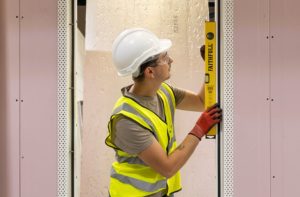
The only product of its kind currently available, the expertly engineered PRECISION adjustable frame completely transforms the installation process for construction professionals and streamlines the specification process for architects and specifiers.
This is achieved through the product’s unique construction, which enables the frame to be fully self-adjusting to the specific dimensions of each structural opening, ensuring the installation is fit for purpose providing the highest standards in accuracy and removing the requirement for plastic packers for a safer, faster and simpler installation process.
Factory applied intumescent strips to the outer frame also eliminates the need for intumescent mastic application as a secondary operation on site when installing the frame.
The PRECISION frame dramatically reduces fitting times and eliminates the risk of using non-compliant components throughout installation, which may not have been tested in conjunction with the riser door itself.
The patent pending PRECISION adjustable frame is now supplied as standard with Profab Access’ high quality steel INTEGRA 4000 Series Fire Rated Riser Doors.
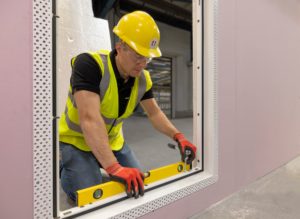
Profab Access was the first UK manufacturer to have its concealed Riser Doors bi-directionally fire tested and certified by an accredited third party. The PRECISION adjustable frame has also been bi-directionally fire tested as an entire doorset with the INTEGRA 4000 Series Riser Door for up to 120 minutes, receiving the CERTIFIRE accreditation for installation in unlined shaft walls and solid wall construction.
This provides architects, specifiers and contractors with a completely certified solution, as both the frame and the riser door have been bi-directionally tested as a single doorset and are supplied with comprehensive documentation to evidence their performance credentials and adherence to all relevant regulations, including BS EN 1634-1:2014 +A1:2018.
Marcus Parnham, Commercial Director at Profab Access, said: “As one of the industry’s leading manufacturers, we have a responsibility to push the boundaries of this product category and ensure every access solution we supply delivers the highest standards in performance and compliance.
“Our new patent pending PRECISION adjustable frame represents a real step change for the industry, supporting professionals in fulfilling their duty of care by going above and beyond current legislation in delivering the highest standards of due diligence and achieving constant compliance for the entire doorset, including the materials used throughout the installation process. The frame is the result of our unwavering commitment to innovation and providing the built environment with the very highest standards in access solutions.”
The PRECISION adjustable frame is constructed with an all-in-one smoke, intumescent and acoustic FS1000 seal, eliminating the need for additional intumescent mastic when installing the frame into a flexible or solid wall construction. This cost efficient and sustainable material contains no halogen compounds and will not emit toxic gas when heated, ensuring the safety of building occupants in the event of a fire.
As an official Made in Britain member, Profab Access’ comprehensive portfolio of Riser Doors and Access Solutions are manufactured at its headquarters in Atherstone by its experienced team of design and engineering experts.

For further information on Profab Access and its range of riser doors, access panels, and steel doors, call +44(0)1827 718222 or visit www.profabaccess.com.
View Access 360's profile:
Vortice ‘Brand Leader’ Interview Podcast 2 – Transcript to support learning
Story
‘Good Ventilation: Heat Recovery Systems And The Role They Play’
Vortice ‘Brand Leader’ Interview Podcast Series – Transcript to support learning
Every effort has been made to flawlessly transcribe the interview to support learning but please consider the recorded audio of the interview as the actual source of information for learning purposes.
Hi this is Mick de Leiburne for BusinessNet Explorer
And welcome to the – second out of six – in our ‘special edition’ series of ‘Brand Leader’ podcasts, where we discuss how Good Ventilation can be achieved in the home and in the workplace – with Vortice thought leadership and product solutions.
Well, as the world recognises the role of Good Ventilation, Jennifer Quinn, Marketing Manager at Vortice joins us today – to talk about Heat Recovery Systems and the role they play…
Jennifer joins us on the phone…
Hi Jennifer, good to get another chance – to tap into your knowledge – on the key areas of Good Ventilation on the BusinessNet Explorer podcast and today we are focussing on Heat Recovery Systems.
Hi Mick, yes I am looking forward to discussing all about Heat Recovery today and the features of it.
Well let’s start today with ‘What are heat recovery systems?’
A heat recovery unit is a centralised mechanical ventilation system which recovers the heat and energy contained in stale indoor air before extracting it, by passing it over a heat exchanger and then adding the recovered energy, be it warm or cold back into the rooms.
So, are heat recovery units actually all about energy efficiency?
That’s part of the story yes, the units are designed to recover the air energy within a building, be it warm or cold, and then the units put a percentage of that back into the home, therefore your heating doesn’t have to work as hard and therefore heating bills are lower which is a cost saving. There are also huge additional benefits too.
In a post-pandemic world, the importance of good ventilation and indoor air quality has had a spotlight shone upon it – heat recovery units not only bring fresh air continuously into the building, they also filter the air that they introduce.
What sort of heat recovery units does Vortice offer?
VORTICE offers a whole collection of heat recovery units – domestic, commercial, industrial – specifically designed to assist with good air quality and filtration whilst ensuring the best of our energy efficient features. The family of heat recovery units offered by VORTICE includes filters which can take out many of the pollutants in the atmosphere.
Because the VORTICE heat recovery unit filters the fresh air being introduced into a property, it helps to protect the health of the occupants and reduce the risk of transferring viruses. People spend up to 90% of their time indoors and with growing evidence of airborne pathogens and viruses moving around our buildings, it is really vital to ensure a building has effective ventilation.
*Good Ventilation is increasingly becoming recognised as a ‘must have’. How would you summarise – the need for Heat Recovery – and the product solutions you have developed at Vortice?
Good ventilation, specifically Heat Recovery, is fundamental in reducing the spread of bacteria and virus and a continuously running heat recovery unit ensures a constant supply of fresh filtered air into the home. Our range covers domestic heat recovery units from our small HR200 unit, to our Passivhaus accredited Avel 450 D. We also have a wide range of commercial and industrial heat recovery units like the Vort Invisible Mini, which is Void mounted, ideal for hotel rooms.
Government advisors have been reiterating the important role that ventilation plays in our health during this recent pandemic and the VORTICE heat recovery systems can certainly impact upon the quality of the indoor air in our homes.
This week, the British Heart Foundation have done ‘Love Your Lungs Week’ which is highlighting the fight for clean air so its really appropriate that we are talking about this today.
Yes, it is a fantastic initiative. Well Jennifer thank you again for joining us today on this – second in a series of six – special edition BNE Product News ‘Brand Leader’ interview podcasts with Vortice – discussing best practice in Good Ventilation.
Thank you Mick, thank you for your time today
Always a pleasure.
For more information about the Vortice range of products, please go to www.vortice.ltd.uk
View Vortice's profile:
Vortice ‘Brand Leader’ Interview Podcast 1 – Transcript to support learning
Story
‘The importance of Good Ventilation in the Indoor Workplace’
Vortice ‘Brand Leader’ Interview Podcast – Transcript to support learning
Every effort has been made to flawlessly transcribe the interview to support learning but please consider the recorded audio of the interview as the actual source of information for learning purposes.
Hi this is Mick de Leiburne and welcome to this special edition of the BNE Product News ‘Brand Leader’ podcast for the Construction & Building Services industry, where we look at product innovations that meet the evolving specification needs for product specifiers.
Well, as the ‘new normal’ starts to take shape, lockdown eases and people are encouraged to return to the workplace, there’s a huge emphasis on how to make buildings healthier places to be and nothing more so, than how important good ventilation in indoor spaces is to mitigating the spread of airborne viruses, micro-organisms and bacteria and also to the wellbeing of the occupants helping people to feel more invigorated in the workplace. Better for workers and better for employers with everyone feeling protected and revitalised by a constant flow of clean air in the room.
Well, one way, dependent on where your workplace may be, is to open a window or vent or alternatively you can tap into the possibilities that advances in technology offer, like Vortice, a brand that is focussing on Air Purification as a solution – and we are lucky enough to have Jennifer Quinn, Marketing Manager at Vortice with us today to explain how that works and how effective it can be in making people feel safe and great in the workplace environment.
Jennifer joins us on the phone….
Hi Jennifer, thanks for joining us today for this BNE Product News ‘Brand Leader’ podcast – I know how busy you are
Hi Mick, thank you for inviting me today to talk about ventilation.
Well Jennifer, let’s start with ‘Why is ventilation in our indoor spaces important’?
At Vortice, we’ve always had a strong focus on the health benefits of good ventilation, people spend around 90% of their time indoors and unless we take steps to ventilate our homes and workplaces correctly, the quality of the air we breathe can be 50 x more polluted than outdoor air, with all the associated health risks. Symptoms like dizziness, watery eyes, fatigue, headaches coughing.
We also only need to contemplate the number of cleaning products we use within our houses, hair sprays, paints, air fresheners, carpets. All of these things we bring into our buildings that are feeding our indoor air quality. This can cause issues like condensation and mould which can worsen skin allergies and possibly respiratory conditions. Also, today’s new build buildings tend to be extremely airtight, which has its benefits in terms of heating bills and insulation, but does cause issues with fresh air coming into the property.
And why now, in particular, would you say – it is more important than ever – in the indoor Workplace?
As everyone is aware at the minute, the current pandemic, with Covid, its never been more important now to think about the air you breathe, especially indoors and the Government have given a raft of information supporting the needs to ventilate properly, and they explain things like in poorly ventilated rooms the amount of virus in the air can build up increasing the spread of Covid, especially if there is a lot of infected people in the room. The virus can also remain in the air after the infected person has left, so bringing fresh air into a room and removing older stale air that contains virus reduces the chance of spreading Covid 19. The more fresh air that is brought inside or [older stale air] extracted out of the room the quicker any air borne virus will be removed.
What are the key products that can help to achieve these goals would you say?
Vortice believe there are 3 fundamental factors in helping reduce the spread of Covid 19. They are Ventilation, Purification and Sanitisation. So first stage is to make sure your room is well ventilated by means of an adequate fan to remove the stale air or to open a window. The next stage would be to make sure the air is purified, so we have a range of air purifiers called the Depuro Pro and these include HEPA filters which are able to retain up to 99.995% of pollutants and reduce the risk of pathogens such as virus and bacteria There is also a version with a photocatalysis UVC lamp which also sanitises by removing bacteria and virus which makes this extremely effective against the spread of Covid and other viruses. We’ve had excellent feedback from these units used in hospitals, care homes, gyms, nurseries. And then the third stage would be to sanitise. Other than having a range of hand dryers and soap dispensers we’ve recently launched a UVLOGIKA SYSTEM, which is a germicidal UV-C lamp, which is ideal for disinfecting surfaces. Its radiation quickly eliminates up to 99% of bacteria, virus and other pathogens that are deposited on surfaces.
Well that’s a fantastic range that seems to cover all the bases. And finally, how do you see this product range developing in the next few years – the increasing focus on the need to improve the quality of the air that we breathe indoors, in such a variety of settings, must provide a great scope for product development ?
Yes, so we are always continually looking at expanding our ventilation, purification and sanitisation range and we are looking always to grow our product ranges in Domestic, Commercial and Industrial. We have recently just acquired a Spanish company, Casals Ventilation, which is going to enable us to expand our industrial offering on the market, so going forward we really want to be innovative and pro-active in regards to product development to the environment and issues that surround us.
Well Jennifer, thank you again for joining us for this BNE Product News ‘Brand Leader’ podcast today. Vortice are clearly one of the leading lights in the world of ‘clean air’ ventilation ‘product research, design and development’, with an innovative range of products available – that are designed to help us all to stay safe and feel good – as we return to our shared indoor workspaces!
Thank you Mick – thank you for your time.
It’s been an absolute pleasure.
For more information about the Vortice range of products, please go to www.vortice.ltd.uk
View Vortice's profile:
Crittall Leeds the way
Story
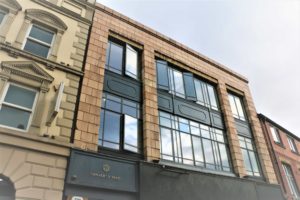
Original Crittall windows have been replaced and upgraded on the main street frontage of one of Leeds’ most historic quarters.
Briggate is a pedestrianised principal shopping street in the city centre containing many historic buildings including, tucked away from view in Lamberts Yard, the only remaining Elizabethan timber framed property in the City dating back to circa 1600.
The walkway leading to that heritage enclave passes through No. 162 Briggate, a 1950’s
vintage commercial and residential block where Think Architecture has installed replacement Crittall steel windows.
“No.162 had original Crittalls and, as with all the buildings around Lamberts Yard, things were in various appalling states,” said Simon Smithson, director of Pudsey, West Yorkshire-based, Think Architecture.
The original single glazed windows in the three-storey no.162 were replaced with double glazed lookalike Homelight windows. The building now houses new apartments and a ground-floor commercial premises.
“I have to say,” added Mr Smithson, “ that the Crittall windows are a wonderful system. Several years ago we did a job and used what was described as a ‘Crittall-like’ system. Well, that was very disappointing whereas the Crittall system is a great system, so well made.” www.crittall-windows.co.uk
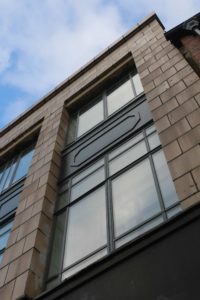
View Crittall's profile:
BNE delivers bite-sized learning opportunity for Specifiers and Buyers
Story
BusinessNet Explorer is an evolving bite-sized learning platform – delivering product news and information for product Specifiers and Buyers in the Construction & Building Services industry and associated Manufacturing and Energy sectors – in engaging Audio, Visual and Audio/Visual formats – via its Virtual Exhibition and Podcast Channels.
Specifiers and Buyers can learn about new products, product range updates, branding updates, exhibition appearances, explore case studies and application stories, find out about new CPD’s and Webinars – and listen to the BNE Product News ‘Brand Leader’ interview series of podcasts – to hear manufacturer thought leaders discuss state-of-the-art product innovations – designed to meet and often exceed the latest industry product specification requirements.
A spokesperson for BusinessNet Explorer revealed how the BNE platform can also support Continuing Professional Development for specifiers and buyers ”BNE is a hub of bite-sized / micro-learning product news and information content that allows Manufacturers to reach ‘on the move’ multi-workspace based specifiers and buyers via its Virtual Exhibition and Podcast Channels in engaging ‘easy to digest’’ educational chunks, that in many cases, such as the ‘Brand Leader’ interviews that are also available in Audio podcast format on Google Podcasts, Apple / iTunes and Spotify and the case studies/application stories that can also be found in our Audio/Visual podcast library, could go toward meeting any targets that may be set for annual ‘Reflective CPD / Passive Learning and ‘Self-Directed / Unstructured Learning’ CPD points. Each podcast has a transcript to support learning and CPD”
Dave Marshall-George, Sales Director at Humidification specialist manufacturer Condair, interviewed recently by Mick de Leiburne for a BNE ‘Brand Leader’ podcast explains, “Podcasts are a great way for engineers to listen and learn whilst in their car or on their way to work. We wanted to engage with this bite-sized learning channel to deliver useful information on a topic we are seeing more and more interest in from consultants and AHU companies. Our short podcast on evaporative cooling is very easy listening and perfect for a 10-minute coffee break escape.”
Click to hear the Condair Podcast: https://soundcloud.com/businessnetexplorer/construction-building-services-bne-product-news-condair-brand-leader-interview
To catch up with the latest industry product news and information in ‘easy to digest’ bite-sized learning formats – wherever and whenever you are available – just visit www.BusinessNetExplorer.com
